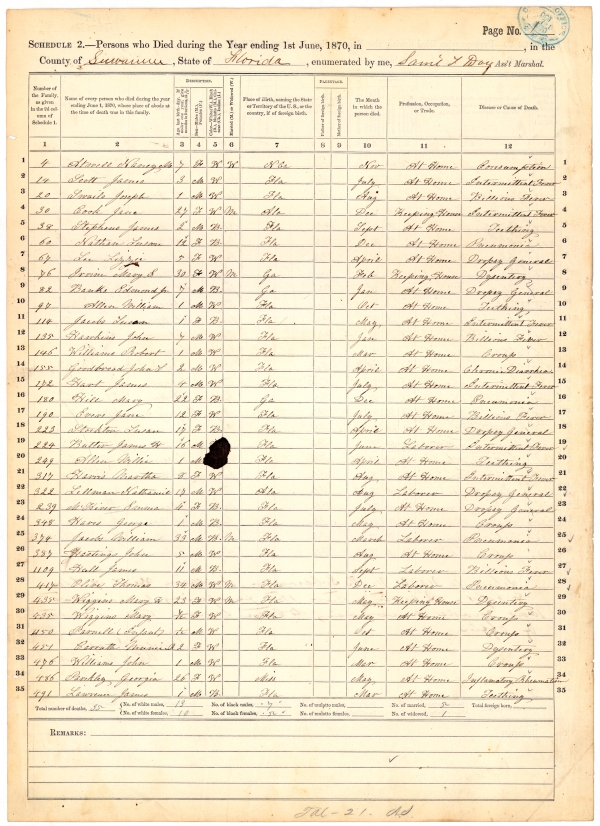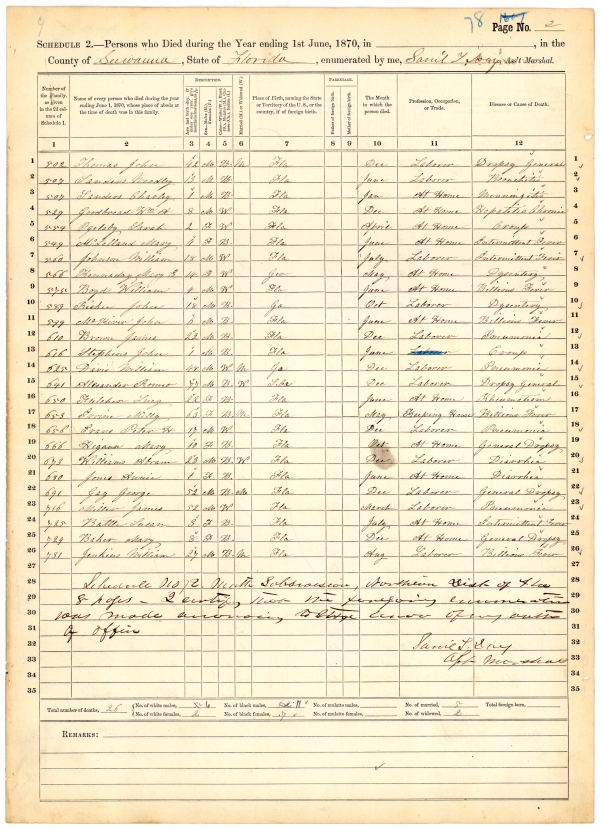Florida Memory is administered by the Florida Department of State, Division of Library and Information Services, Bureau of Archives and Records Management. The digitized records on Florida Memory come from the collections of the State Archives of Florida and the special collections of the State Library of Florida.

State Archives of Florida
- ArchivesFlorida.com
- State Archives Online Catalog
- ArchivesFlorida.com
- ArchivesFlorida.com
State Library of Florida
Related Sites

Description of previous item
Description of next item

Source
Description
Date
Contributors
Format
Personal Subjects
Allen, William, ca.1869-ca.1870
Allen, Willie, ca.1869-ca.1870
Atwell, Haney M., ca.1863-ca.1870
Baker, Mary, ca.1862-ca.1870
Banks, Edmond, Jr., ca.1863-ca.1870
Battle, Susan, ca.1867-ca.1870
Boyd, William, ca.1866-ca.1870
Brown, James, ca.1848-ca.1870
Butter, James H., ca.1854-ca.1870
Carruth, Muriel, ca.1868-ca.1870
Cook, Jane, ca.1843-ca.1870
Davis, William, ca.1822-ca.1870
Evans, Peter H., ca.1853-ca.1870
Evers, Jane, ca.1858-ca.1870
Fulcher, Lucy, ca.1848-ca.1870
Gay, George, ca.1818-ca.1870
Goodbread, John S., ca.1868-ca.1870
Goodbread, William A., ca.1862-ca.1870
Hall, James, ca.1859-ca.1870
Hares, George, ca.1869-ca.1870
Harris, Martha, ca.1862-ca.1870
Hart, James, ca.1866-ca.1870
Hastings, John, ca.1865-ca.1870
Hawkins, John, ca.1863-ca.1870
Higam, Mary, ca.1860-ca.1870
Hill, Mary, ca.1848-ca.1870
Irvine, Mary S., ca.1840-ca.1870
Irvine, Milly, ca.1807-ca.1870
Jacobs, Susan, ca.1869-ca.1870
Jacobs, William, ca.1837-ca.1870
Jenkins, William, ca.1843-ca.1870
Johnson, William, ca.1852-ca.1870
Jones, Annie, ca.1869-ca.1870
Kenneday, Mary E., ca.1856-ca.1870
Lawrence, James, ca.1869-ca.1870
Lee, Lizzie, ca.1865-ca.1870
Lillman, Nathaniel, ca.1853-ca.1870
McKiver, Emma, ca.1866-ca.1870
McKiver, John, ca.1864-ca.1870
McLelland, Mary, ca.1866-ca.1870
Miller, James, ca.1818-ca.1870
Natahn, Susan, ca.1858-ca.1870
Oglesby, Sarah, ca.1868-ca.1870
Olive, Thomas, ca.1836-ca.1870
Parkley, Georgia, ca.1844-ca.1870
Parnell, [Infant], ca.1870-ca.1870
Riskee, John, ca.1852-ca.1870
Sanders, Charley, ca.1869-ca.1870
Sanders, Woodley, ca.1857-ca.1870
Scott, James, ca.1867-ca.1870
Stephens, James, ca.1868-ca.1870
Stephens, John, ca.1869-ca.1870
Stockton, Susan, ca.1853-ca.1870
Swails, Joseph, ca.1869-ca.1870
Thomas, John, ca.1828-ca.1870
Wiggins, Mary H., ca.1847-ca.1870
Wiggins, Mary, ca.1870-ca.1870
Williams, Abram, ca.1847-ca.1870
Williams, John, ca.1869-ca.1870
Williams, Robert, ca.1869-ca.1870
Geographic Term
| Page | Line | Name | Age | Sex | Race | Cause of Death | Notes |
|---|---|---|---|---|---|---|---|
| 1 | 1 | Atwell, Haney M. | 7 years | Female | White | Consumption Another name for tuberculosis, a bacterial infection of the lungs. | |
| 1 | 2 | Scott, James | 3 years | Male | White | Intermittent fever | |
| 1 | 3 | Swails, Joseph | 1 year | Male | White | Bilious fever | |
| 1 | 4 | Cook, Jane | 27 years | Female | White | Intermittent fever | |
| 1 | 5 | Stephens, James | 2 years | Male | Black | Teething Another name for dentition, the eruption of new teeth in an infant. This process sometimes caused an infection that triggered a fever. In the absence of modern fever reducers or antiseptic agents these infections could sometimes cause serious symptoms and even death (Dunglison, A Dictionary of Medical Science, 1893). | |
| 1 | 6 | Natahn, Susan | 12 years | Female | Black | Pneumonia An infection of the lungs characterized by inflammation and a buildup of fluid that makes it difficult to breathe (Hooper, Lexicon Medicum, 1860). | |
| 1 | 7 | Lee, Lizzie | 5 years | Female | White | Dropsy general | |
| 1 | 8 | Irvine, Mary S. | 30 years | Female | White | Dysentery A range of diseases causing inflammation of the large intestine. Symptoms included fever, severe diarrhea, and abdominal pain. Sometimes this was also called “flux.” The disease was thought to be endemic during the summer months (Dunglison, A Dictionary of Medical Science, 1893). | |
| 1 | 9 | Banks, Edmond, Jr. | 7 years | Male | Black | Dropsy general | |
| 1 | 10 | Allen, William | 1 year | Male | White | Teething Another name for dentition, the eruption of new teeth in an infant. This process sometimes caused an infection that triggered a fever. In the absence of modern fever reducers or antiseptic agents these infections could sometimes cause serious symptoms and even death (Dunglison, A Dictionary of Medical Science, 1893). | |
| 1 | 11 | Jacobs, Susan | 1 year | Female | Black | Intermittent fever | |
| 1 | 12 | Hawkins, John | 7 years | Male | White | Bilious fever | |
| 1 | 13 | Williams, Robert | 1 year | Male | White | Croup A disease mainly attacking infants, in which the mucous membranes of the trachea become inflamed and cause the secretion of a thick mucus that makes it difficult to breathe. Also called cynanche trachealis (Hooper, Lexicon Medicum, 1860). | |
| 1 | 14 | Goodbread, John S. | 2 years | Male | White | Chronic diarrhea | |
| 1 | 15 | Hart, James | 4 years | Male | White | Intermittent fever | |
| 1 | 16 | Hill, Mary | 22 years | Female | Black | Pneumonia An infection of the lungs characterized by inflammation and a buildup of fluid that makes it difficult to breathe (Hooper, Lexicon Medicum, 1860). | |
| 1 | 17 | Evers, Jane | 12 years | Female | White | Bilious fever | |
| 1 | 18 | Stockton, Susan | 17 years | Female | Black | Dropsy general | |
| 1 | 19 | Butter, James H. | 16 years | Male | Black | Intermittent fever | |
| 1 | 20 | Allen, Willie | 1 year | Male | Teething Another name for dentition, the eruption of new teeth in an infant. This process sometimes caused an infection that triggered a fever. In the absence of modern fever reducers or antiseptic agents these infections could sometimes cause serious symptoms and even death (Dunglison, A Dictionary of Medical Science, 1893). | ||
| 1 | 21 | Harris, Martha | 8 years | Female | White | Intermittent fever | |
| 1 | 22 | Lillman, Nathaniel | 17 years | Male | White | Dropsy general | |
| 1 | 23 | McKiver, Emma | 4 years | Female | Black | Dropsy general | |
| 1 | 24 | Hares, George | 1 year | Male | Black | Croup A disease mainly attacking infants, in which the mucous membranes of the trachea become inflamed and cause the secretion of a thick mucus that makes it difficult to breathe. Also called cynanche trachealis (Hooper, Lexicon Medicum, 1860). | |
| 1 | 25 | Jacobs, William | 33 years | Male | Black | Pneumonia An infection of the lungs characterized by inflammation and a buildup of fluid that makes it difficult to breathe (Hooper, Lexicon Medicum, 1860). | |
| 1 | 26 | Hastings, John | 5 years | Male | White | Croup A disease mainly attacking infants, in which the mucous membranes of the trachea become inflamed and cause the secretion of a thick mucus that makes it difficult to breathe. Also called cynanche trachealis (Hooper, Lexicon Medicum, 1860). | |
| 1 | 27 | Hall, James | 11 years | Male | Black | Bilious fever | |
| 1 | 28 | Olive, Thomas | 34 years | Male | White | Pneumonia An infection of the lungs characterized by inflammation and a buildup of fluid that makes it difficult to breathe (Hooper, Lexicon Medicum, 1860). | |
| 1 | 29 | Wiggins, Mary H. | 23 years | Female | White | Dysentery A range of diseases causing inflammation of the large intestine. Symptoms included fever, severe diarrhea, and abdominal pain. Sometimes this was also called “flux.” The disease was thought to be endemic during the summer months (Dunglison, A Dictionary of Medical Science, 1893). | |
| 1 | 30 | Wiggins, Mary | 7 months | Female | White | Croup A disease mainly attacking infants, in which the mucous membranes of the trachea become inflamed and cause the secretion of a thick mucus that makes it difficult to breathe. Also called cynanche trachealis (Hooper, Lexicon Medicum, 1860). | |
| 1 | 31 | Parnell, [Infant] | 1 month | Male | White | Croup A disease mainly attacking infants, in which the mucous membranes of the trachea become inflamed and cause the secretion of a thick mucus that makes it difficult to breathe. Also called cynanche trachealis (Hooper, Lexicon Medicum, 1860). | |
| 1 | 32 | Carruth, Muriel | 2 years | Female | White | Dysentery A range of diseases causing inflammation of the large intestine. Symptoms included fever, severe diarrhea, and abdominal pain. Sometimes this was also called “flux.” The disease was thought to be endemic during the summer months (Dunglison, A Dictionary of Medical Science, 1893). | |
| 1 | 33 | Williams, John | 1 year | Male | White | Croup A disease mainly attacking infants, in which the mucous membranes of the trachea become inflamed and cause the secretion of a thick mucus that makes it difficult to breathe. Also called cynanche trachealis (Hooper, Lexicon Medicum, 1860). | |
| 1 | 34 | Parkley, Georgia | 26 years | Female | White | Inflammatory rheumatism | |
| 1 | 35 | Lawrence, James | 1 year | Male | Black | Teething Another name for dentition, the eruption of new teeth in an infant. This process sometimes caused an infection that triggered a fever. In the absence of modern fever reducers or antiseptic agents these infections could sometimes cause serious symptoms and even death (Dunglison, A Dictionary of Medical Science, 1893). | |
| 2 | 1 | Thomas, John | 42 years | Male | Black | Dropsy general | |
| 2 | 2 | Sanders, Woodley | 13 years | Male | Black | Bronchitis | |
| 2 | 3 | Sanders, Charley | 1 year | Male | Black | Meningitis | |
| 2 | 4 | Goodbread, William A. | 8 years | Male | White | Hepatitis chronic | |
| 2 | 5 | Oglesby, Sarah | 2 years | Female | White | Croup A disease mainly attacking infants, in which the mucous membranes of the trachea become inflamed and cause the secretion of a thick mucus that makes it difficult to breathe. Also called cynanche trachealis (Hooper, Lexicon Medicum, 1860). | |
| 2 | 6 | McLelland, Mary | 4 years | Female | Black | Intermittent fever | |
| 2 | 7 | Johnson, William | 18 years | Male | White | Intermittent fever | |
| 2 | 8 | Kenneday, Mary E. | 14 years | Female | White | Dysentery A range of diseases causing inflammation of the large intestine. Symptoms included fever, severe diarrhea, and abdominal pain. Sometimes this was also called “flux.” The disease was thought to be endemic during the summer months (Dunglison, A Dictionary of Medical Science, 1893). | |
| 2 | 9 | Boyd, William | 4 years | Male | White | Bilious fever | |
| 2 | 10 | Riskee, John | 18 years | Male | Black | Dysentery A range of diseases causing inflammation of the large intestine. Symptoms included fever, severe diarrhea, and abdominal pain. Sometimes this was also called “flux.” The disease was thought to be endemic during the summer months (Dunglison, A Dictionary of Medical Science, 1893). | |
| 2 | 11 | McKiver, John | 6 years | Male | Black | Bilious fever | |
| 2 | 12 | Brown, James | 22 years | Male | Black | Pneumonia An infection of the lungs characterized by inflammation and a buildup of fluid that makes it difficult to breathe (Hooper, Lexicon Medicum, 1860). | |
| 2 | 13 | Stephens, John | 1 year | Male | Black | Croup A disease mainly attacking infants, in which the mucous membranes of the trachea become inflamed and cause the secretion of a thick mucus that makes it difficult to breathe. Also called cynanche trachealis (Hooper, Lexicon Medicum, 1860). | |
| 2 | 14 | Davis, William | 48 years | Male | White | Pneumonia An infection of the lungs characterized by inflammation and a buildup of fluid that makes it difficult to breathe (Hooper, Lexicon Medicum, 1860). | |
| 2 | 15 | Alexander, Romeo | 77 years | Male | Black | Dropsy general | |
| 2 | 16 | Fulcher, Lucy | 22 years | Female | Black | Rheumatism | |
| 2 | 17 | Irvine, Milly | 63 years | Female | Black | Bilious fever | |
| 2 | 18 | Evans, Peter H. | 17 years | Male | White | Pneumonia An infection of the lungs characterized by inflammation and a buildup of fluid that makes it difficult to breathe (Hooper, Lexicon Medicum, 1860). | |
| 2 | 19 | Higam, Mary | 10 years | Female | Black | General dropsy | |
| 2 | 20 | Williams, Abram | 23 years | Male | Black | Diarrhea Family members, census takers, and even medical professionals often gave this as a cause of death for any disease where the deceased had suffered from a prolonged intestinal complaint and a more specific diagnosis could not be made. | |
| 2 | 21 | Jones, Annie | 1 year | Female | Black | Diarrhea Family members, census takers, and even medical professionals often gave this as a cause of death for any disease where the deceased had suffered from a prolonged intestinal complaint and a more specific diagnosis could not be made. | |
| 2 | 22 | Gay, George | 52 years | Male | Black | General dropsy | |
| 2 | 23 | Miller, James | 52 years | Male | White | Pneumonia An infection of the lungs characterized by inflammation and a buildup of fluid that makes it difficult to breathe (Hooper, Lexicon Medicum, 1860). | |
| 2 | 24 | Battle, Susan | 3 years | Female | Black | Intermittent fever | |
| 2 | 25 | Baker, Mary | 8 years | Female | Black | General dropsy | |
| 2 | 26 | Jenkins, William | 27 years | Male | Black | Bilious fever |
Title
Subject
Description
Creator
Source
Date
Contributor
Format
Language
Type
Identifier
Coverage
Transcript
| Page | Line | Name | Age | Sex | Race | Cause of Death | Notes |
|---|---|---|---|---|---|---|---|
| 1 | 1 | Atwell, Haney M. | 7 years | Female | White | Consumption | |
| 1 | 2 | Scott, James | 3 years | Male | White | Intermittent fever | |
| 1 | 3 | Swails, Joseph | 1 year | Male | White | Bilious fever | |
| 1 | 4 | Cook, Jane | 27 years | Female | White | Intermittent fever | |
| 1 | 5 | Stephens, James | 2 years | Male | Black | Teething | |
| 1 | 6 | Natahn, Susan | 12 years | Female | Black | Pneumonia | |
| 1 | 7 | Lee, Lizzie | 5 years | Female | White | Dropsy general | |
| 1 | 8 | Irvine, Mary S. | 30 years | Female | White | Dysentery | |
| 1 | 9 | Banks, Edmond, Jr. | 7 years | Male | Black | Dropsy general | |
| 1 | 10 | Allen, William | 1 year | Male | White | Teething | |
| 1 | 11 | Jacobs, Susan | 1 year | Female | Black | Intermittent fever | |
| 1 | 12 | Hawkins, John | 7 years | Male | White | Bilious fever | |
| 1 | 13 | Williams, Robert | 1 year | Male | White | Croup | |
| 1 | 14 | Goodbread, John S. | 2 years | Male | White | Chronic diarrhea | |
| 1 | 15 | Hart, James | 4 years | Male | White | Intermittent fever | |
| 1 | 16 | Hill, Mary | 22 years | Female | Black | Pneumonia | |
| 1 | 17 | Evers, Jane | 12 years | Female | White | Bilious fever | |
| 1 | 18 | Stockton, Susan | 17 years | Female | Black | Dropsy general | |
| 1 | 19 | Butter, James H. | 16 years | Male | Black | Intermittent fever | |
| 1 | 20 | Allen, Willie | 1 year | Male | Teething | ||
| 1 | 21 | Harris, Martha | 8 years | Female | White | Intermittent fever | |
| 1 | 22 | Lillman, Nathaniel | 17 years | Male | White | Dropsy general | |
| 1 | 23 | McKiver, Emma | 4 years | Female | Black | Dropsy general | |
| 1 | 24 | Hares, George | 1 year | Male | Black | Croup | |
| 1 | 25 | Jacobs, William | 33 years | Male | Black | Pneumonia | |
| 1 | 26 | Hastings, John | 5 years | Male | White | Croup | |
| 1 | 27 | Hall, James | 11 years | Male | Black | Bilious fever | |
| 1 | 28 | Olive, Thomas | 34 years | Male | White | Pneumonia | |
| 1 | 29 | Wiggins, Mary H. | 23 years | Female | White | Dysentery | |
| 1 | 30 | Wiggins, Mary | 7 months | Female | White | Croup | |
| 1 | 31 | Parnell, [Infant] | 1 month | Male | White | Croup | |
| 1 | 32 | Carruth, Muriel | 2 years | Female | White | Dysentery | |
| 1 | 33 | Williams, John | 1 year | Male | White | Croup | |
| 1 | 34 | Parkley, Georgia | 26 years | Female | White | Inflammatory rheumatism | |
| 1 | 35 | Lawrence, James | 1 year | Male | Black | Teething | |
| 2 | 1 | Thomas, John | 42 years | Male | Black | Dropsy general | |
| 2 | 2 | Sanders, Woodley | 13 years | Male | Black | Bronchitis | |
| 2 | 3 | Sanders, Charley | 1 year | Male | Black | Meningitis | |
| 2 | 4 | Goodbread, William A. | 8 years | Male | White | Hepatitis chronic | |
| 2 | 5 | Oglesby, Sarah | 2 years | Female | White | Croup | |
| 2 | 6 | McLelland, Mary | 4 years | Female | Black | Intermittent fever | |
| 2 | 7 | Johnson, William | 18 years | Male | White | Intermittent fever | |
| 2 | 8 | Kenneday, Mary E. | 14 years | Female | White | Dysentery | |
| 2 | 9 | Boyd, William | 4 years | Male | White | Bilious fever | |
| 2 | 10 | Riskee, John | 18 years | Male | Black | Dysentery | |
| 2 | 11 | McKiver, John | 6 years | Male | Black | Bilious fever | |
| 2 | 12 | Brown, James | 22 years | Male | Black | Pneumonia | |
| 2 | 13 | Stephens, John | 1 year | Male | Black | Croup | |
| 2 | 14 | Davis, William | 48 years | Male | White | Pneumonia | |
| 2 | 15 | Alexander, Romeo | 77 years | Male | Black | Dropsy general | |
| 2 | 16 | Fulcher, Lucy | 22 years | Female | Black | Rheumatism | |
| 2 | 17 | Irvine, Milly | 63 years | Female | Black | Bilious fever | |
| 2 | 18 | Evans, Peter H. | 17 years | Male | White | Pneumonia | |
| 2 | 19 | Higam, Mary | 10 years | Female | Black | General dropsy | |
| 2 | 20 | Williams, Abram | 23 years | Male | Black | Diarrhea | |
| 2 | 21 | Jones, Annie | 1 year | Female | Black | Diarrhea | |
| 2 | 22 | Gay, George | 52 years | Male | Black | General dropsy | |
| 2 | 23 | Miller, James | 52 years | Male | White | Pneumonia | |
| 2 | 24 | Battle, Susan | 3 years | Female | Black | Intermittent fever | |
| 2 | 25 | Baker, Mary | 8 years | Female | Black | General dropsy | |
| 2 | 26 | Jenkins, William | 27 years | Male | Black | Bilious fever |
Collection ID
Subject - Person
ImageID
Thumbnail
Geographic Term
Chicago Manual of Style
United States. Department of the Interior. Suwannee County Mortality Schedule for the Federal Census of 1870. 1870. State Archives of Florida, Florida Memory. <https://www.floridamemory.com/items/show/345742>, accessed 18 December 2025.
MLA
United States. Department of the Interior. Suwannee County Mortality Schedule for the Federal Census of 1870. 1870. State Archives of Florida, Florida Memory. Accessed 18 Dec. 2025.<https://www.floridamemory.com/items/show/345742>
AP Style Photo Citation
(State Archives of Florida/United States. Department of the Interior.)

 Listen: The World Program
Listen: The World Program